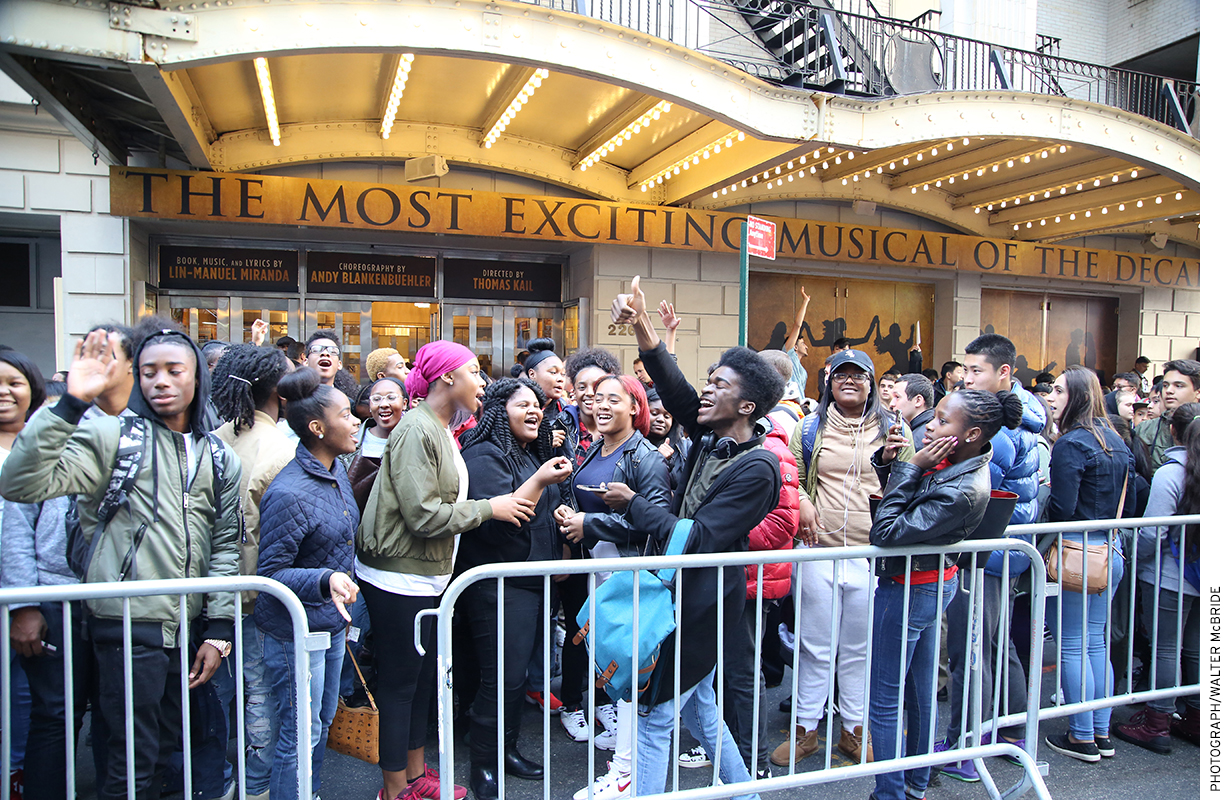
It’s 10 o’clock on a Wednesday morning at New York City’s Richard Rodgers Theatre, and the buzz in the house is palpable. The matinee of Hamilton, the acclaimed musical about the “10-dollar founding father without a father,” won’t start for four hours, but the audience of 11th-grade students is ready. While most of the play’s actors aren’t even in the building yet, the show is about to begin.
Backstage a group of about 35 high schoolers take selfies, warm up their voices, and pace. They are getting ready to mount the same stage where the play that won 11 Tony Awards is presented eight times a week. In a flash, Okieriete Onaodowan, the actor who plays Hercules Mulligan and James Madison, appears in the wings.
“EduHam” is on.
Long before the play about the nation’s first treasury secretary opened in February 2015, its creator, writer, and star Lin-Manuel Miranda knew his work would be useful for teachers. That’s because before Hamilton won a Pulitzer, a Grammy, and all those Tonys, before its cast album was streamed a half billion times on Spotify alone, before the top ticket prices soared to a Broadway record $849, Miranda debuted the show’s first song, “Alexander Hamilton,” at the White House Poetry Jam in 2009.
When video of the four-and-a-half-minute performance hit YouTube, the number-one comment posted was, “My teacher showed us this in APUSH,” Miranda told Newsweek, using the acronym for the AP U.S. History class.
So six years later, when the play first opened at the Public Theater, Hamilton biographer Ron Chernow invited Lesley S. Herrmann, then executive director of the Gilder Lehrman Institute of American History, to be his guest at the show. The two had common interests. It was Chernow’s 818-page biography of Hamilton that had kindled Miranda’s interest in the material and that became the inspiration for the hit musical. Gilder Lehrman, based in New York City, is a nonprofit dedicated to supporting history education.
As soon as the stage went dark that night, Herrmann turned to Chernow and said, “We have to get this into the hands of kids.”
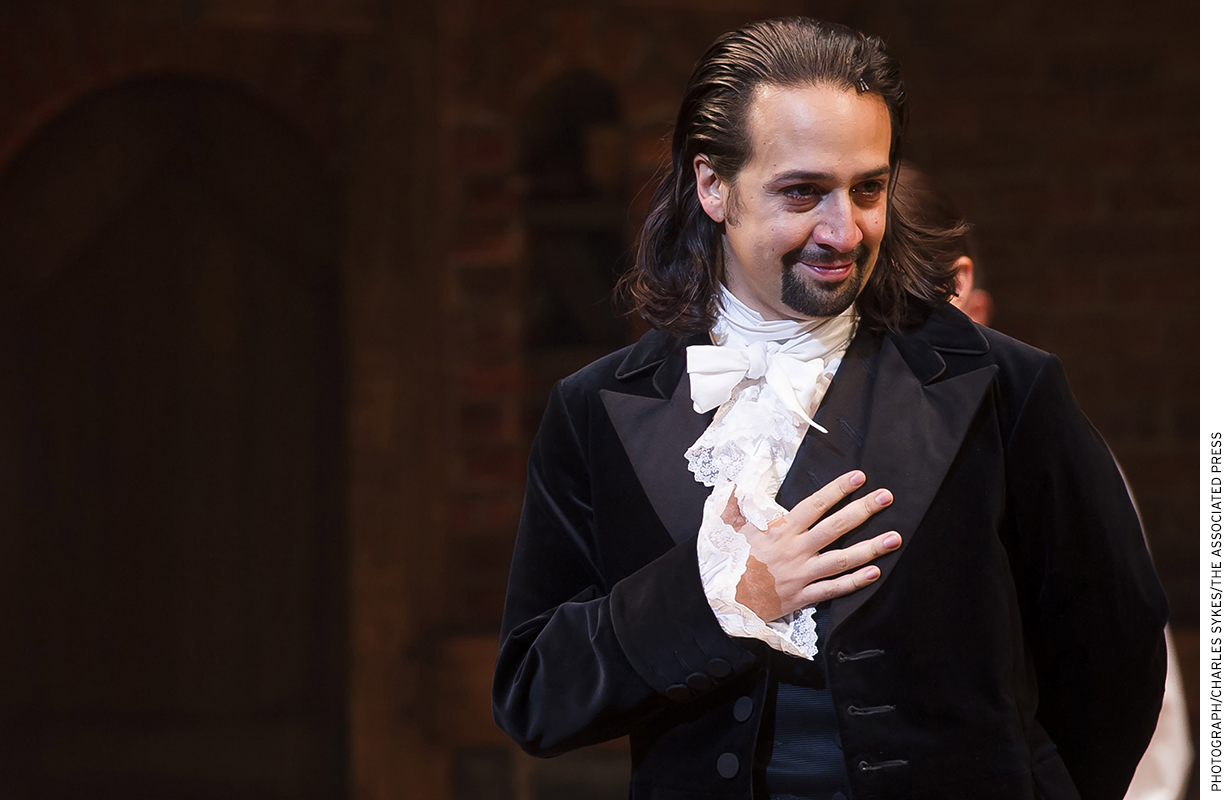
Students Onstage
Fast-forward to that Wednesday morning at the Richard Rodgers Theatre, in November 2016.
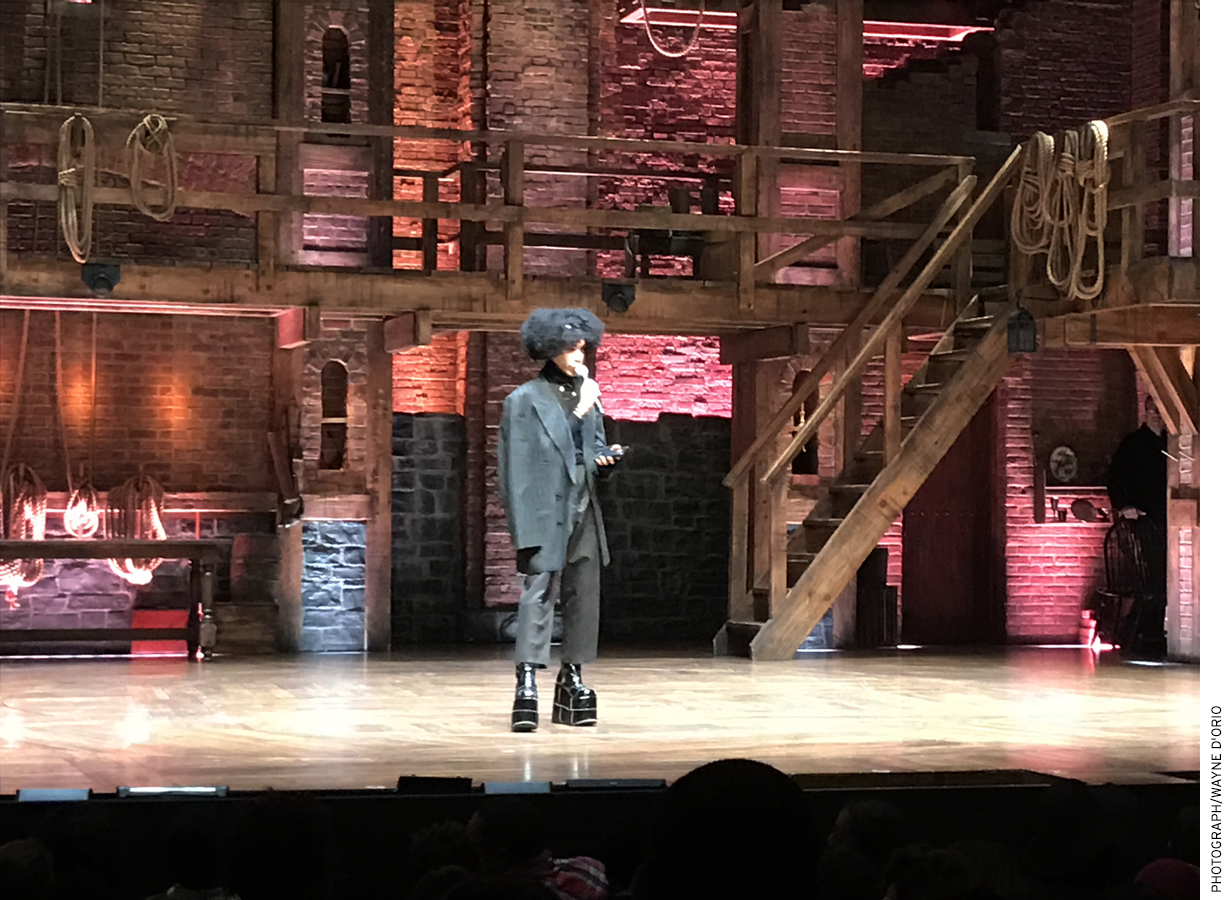
As the students look over their material and emcee Onaodowan goes onstage to welcome the audience, Lulu Rivera stands by himself. The Harvey Milk High School junior will perform a spoken-word piece about Hamilton’s best friend, John Laurens. Rivera based his piece on the long, intimate letters the two wrote to each other. Clad spectacularly in black and wearing a pair of platform boots, Rivera says, “I tried to dress like history, but mostly like Prince.”
During his performance, he’ll earn solid applause from the 1,300 students in the audience. But the most raucous reception will be saved for the rock-’em, sock-’em performance of Traci Ann Pauda and Madeline Ferraris from the Brooklyn School for Music and Theatre. The duo portray Hamilton’s wife, Elizabeth (Eliza) Schuyler, and his mistress, Maria Reynolds, locked in a fight over their man, swapping insults and even shoves as the crowd hoots its approval.
Later in the program, after another group of students trade invectives in a rap battle, Onaodowan comes onstage and jokes to the audience, “That hurt my feelings. I know they were acting, but …”
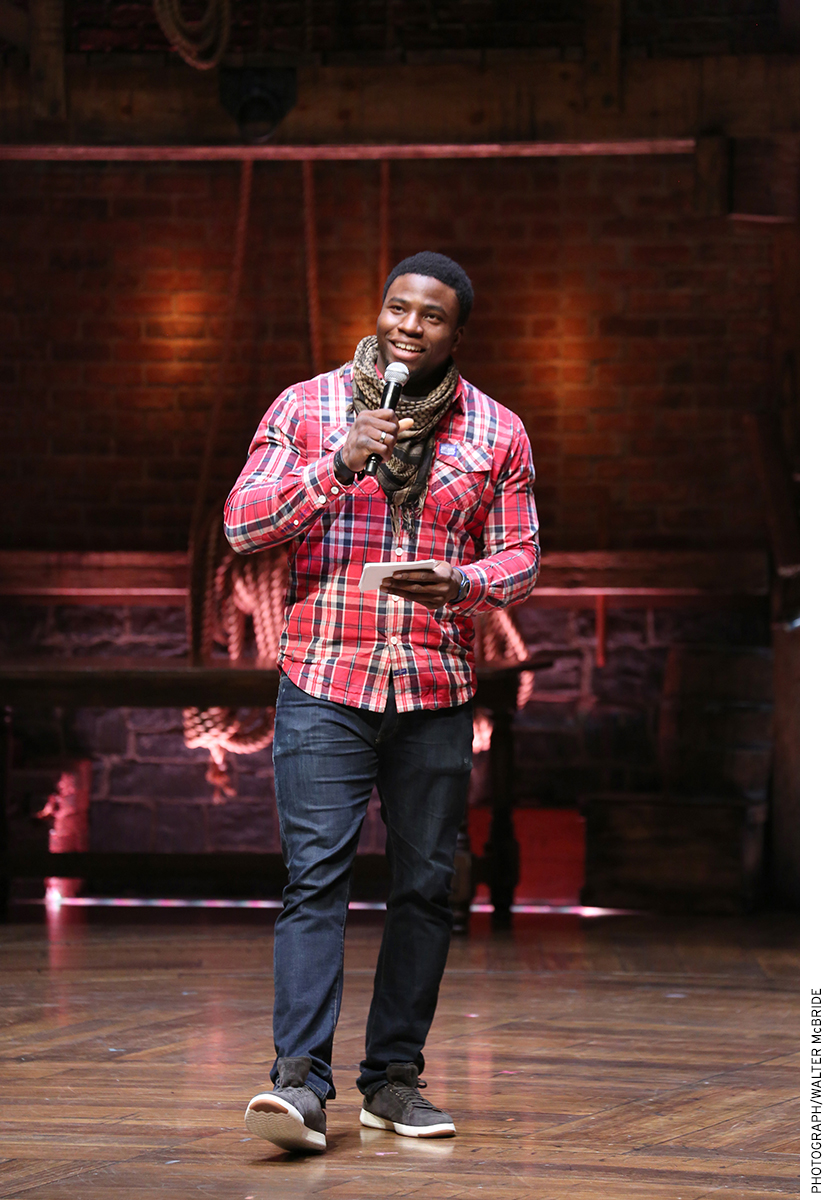
The student performances are the capstone of their participation in EduHam—officially known as the Hamilton Project—an in-class history curriculum based on Hamilton. After their presentations, the students will participate in a “talkback” session with members of Hamilton’s cast, break for lunch, and then return to watch the matinee performance of the play.
During 2016–17, its pilot year in the New York Public Schools, the education program has become almost as successful as the play itself. As it wraps up its first year, the program will bring 20,000 11th graders to the 46th Street theater to perform and to see the play; that’s one out of every four juniors in the nation’s largest school district. EduHam expanded to Chicago in February 2017, and it followed the touring company when the play opened in San Francisco in March.
The total number of students served at the end of the school year will be more than 35,000, says Sasha Rolon Pereira, the director of Gilder Lehrman’s Hamilton Project.
“In the next four years, we will reach 100,000 kids in 50 to 100 cities,” adds James G. Basker, Gilder Lehrman’s president.
If the results on the National Assessment of Educational Progress are any indication, the teaching of American history can use this leg up. Although the average student score in U.S. history climbed a bit between 2001 to 2014, it remains well below the level indicating proficiency. Only about 10 percent of students passed that benchmark.
The Creation of EduHam
So how did the hottest show on Broadway team up with a nonprofit organization and a major foundation in an attempt to reinvent how American history is taught—and motivate 16-year-olds to interact with primary documents from 240 years ago?
Unlike the writing of the play, which took Miranda and his co-creators the better part of seven years, the partnership between Hamilton, Gilder Lehrman, and the Rockefeller Foundation was a whirlwind project, going from idea to fully realized program in less than a year. But in a sense, the seeds of the project were sown much earlier.
Miranda knew how empowering it feels for a young person to create his own artistic project; indeed, that’s how he got his start in musical theater. He wrote three original songs when he was in 8th grade to help teach classmates the content of The Chosen, a novel by Chaim Potok set in 1940s Brooklyn. “My first musical I ever wrote was a class assignment,” Miranda revealed to Arrive magazine.
Hamilton producer Jeffrey Seller himself has a history of bringing Broadway to high school students. He created an educational program for the 1990s musical Rent, his first theatrical success.
And Gilder Lehrman has a long track record of developing history programs that benefit schools. Indeed, two-thirds of the students who take AP U.S. History visit the institute’s web site, and its total traffic jumped to 10 million visitors last year, up from fewer than 2 million two years ago. So when Seller and Miranda’s father, Luis Miranda Jr., visited Gilder Lehrman’s 45th Street office last summer, the institute’s director of education, Tim Bailey, showed them a recent curriculum program he had written called Vietnam in Verse. The lesson plan used poetry and music from the 1960s and ’70s to address the issues of that era. Seller was impressed: “You’re in,” he told Bailey. A partnership was born.
Working through the finances to create the education program was a complicated task. The first hurdle was to get the production to discount all seats for the student matinees. About 1,100 of the Richard Rodgers Theatre’s 1,321 seats cost between $179 and $199 apiece for a performance of Hamilton. The 200 or so center-orchestra seats fetch $849, by far the highest ticket price on Broadway. The play, which nets close to $2 million per week, is sold out until November 2017. The play’s principals agreed to sell the tickets for student matinees for $70, essentially the breakeven price point.
In October 2015, the Rockefeller Foundation put up $1.5 million to pay for Gilder Lehrman to create the curriculum and to subsidize $60 of each student ticket. Students pay the remaining $10 (a “Hamilton”) for each ticket, so they’re invested (except in San Francisco, where students attended for free because of a strict state law that prohibits them from paying for any educational experiences).
“Works like this don’t come around very often, and when they do we must make every effort to maximize their reach,” says Judith Rodin, former president of the Rockefeller Foundation. “Here’s a story that talks about American history and the ideals of American democracy . . . in a vernacular that speaks to young people, written by a product of New York public education,” Rodin told the New York Times. “Could there possibly be a better combination in terms of speaking to students?”
In June 2016 the foundation upped its commitment to $6 million to fund year two of EduHam in New York City and extend it to Chicago and the touring company.
Teachers have applauded the project. “One thing we always try to do as social studies educators is to make content from the past relevant and meaningful to students today,” says Stephen LaMorte, president of the New York State Council for the Social Studies. “It’s exciting to be able to tie important historical events like the founding of our country to such a high-profile piece of popular culture.”
Popular culture has been used for decades to help teach history and other topics. Lawrence Paska, executive director of the National Council for the Social Studies, mentions films such as Glory and JFK. Teachwithmovies.org is a popular site that offers lesson plans for using more than 400 films in the classroom, from the Oscar-winning Spotlight to documentaries such as Super Size Me to the 1972 musical 1776.
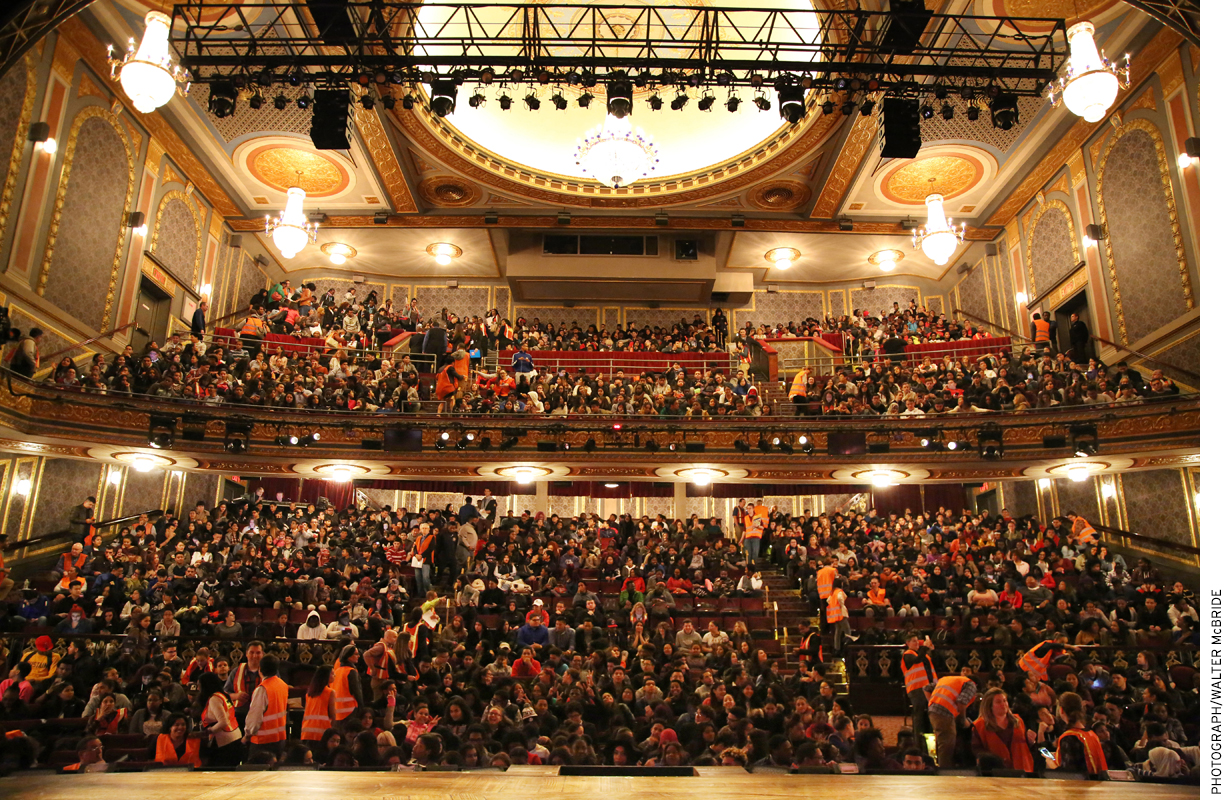
The Curriculum
When Gilder Lehrman’s Tim Bailey started working on the Hamilton Project in late 2015, he knew he wanted to have students deal directly with primary sources. Gilder Lehrman owns 60,000 documents from American history, and Bailey recognized the value of reading and responding to these original materials. Secondary sources that merely summarize such documents and the events behind them tend to simplify the subject and rob students of the opportunity to analyze and interpret them for themselves. And the Common Core State Standards call for increased use of primary documents. But Bailey knew that asking students to read documents written more than 200 years ago could prompt lots of eye rolling.
Gilder Lehrman’s Basker puts it more succinctly: teaching the founding of the country can be the “castor oil of education,” he quips.
Bailey says that to capture kids’ interest in primary materials, “We have to teach the students the skills to unlock those sources. We provide enough structure so that students won’t freak out.”
Bailey’s 24-page study guide attempts to do just that. It starts by laying out the timeline of Hamilton’s life and his era, from his birth in the Caribbean to his death in a duel with Aaron Burr in New Jersey. Students do a close reading of two documents, loyalist Samuel Seabury’s Free Thoughts, on the Proceedings of the Continental Congress and Hamilton’s A Full Vindication of the Measures of the Congress. The guide instructs students to select key words from the excerpts and summarize the readings in language the authors might have used. Then students restate each excerpt in their own words.
In the next segment of the study guide, Bailey has students mine the excerpts from Seabury and Hamilton to discern exactly where each line in the song “Farmer Refuted” originated, teaching them how Miranda transformed facts into verse.
When teachers use films and plays in their instruction, Paska notes, it’s important for them to ask guiding questions so students don’t take fictional portrayals as gospel.
In the companion book to the musical, Hamilton: The Revolution, Miranda adds notes to each of the play’s 40-plus songs, often coming clean about historical inaccuracies. For instance, he writes that while the play depicts the three Schuyler sisters as having no brothers, in reality they had “loads” of them. Miranda leaned on artistic license here because he wanted to portray Angelica Schuyler as a world-class thinker in a society that didn’t accept women as intellectuals, and he thought it would be more effective to omit the four brothers.
Squeezing the details of someone’s life into two and a half hours almost always involves shortcuts. Miranda has Hamilton meet Laurens, Mulligan, and the Marquis de Lafayette in a bar on a single occasion. In fact, Hamilton met the three men separately over a number of years. But the early song “My Shot” propels the play’s action forward and establishes how the four characters will work together against England.
Multimedia Materials
While Bailey worked on the classroom materials, colleagues set up a private Web portal where students could see excerpts from five songs performed during the show. The play’s creators insisted on limiting how much of the piece they would expose, for fear of diluting the play’s potential earnings on tour. Still, says Bailey, “We have amazing access to the show. It’s unprecedented.”
On the web site, students can view nine video interviews created exclusively for them. The videos feature Miranda explaining how Hamilton was different from other Founding Fathers, Chernow discussing the artistic license used in nonfiction writing, and actors reading from original documents of the period.
In one video, Miranda holds an actual love letter from Hamilton to his future wife Eliza and reads: “You not only employ my mind all day; but you intrude upon my sleep. I meet you in every dream and when I wake, I cannot close my eyes again for ruminating on your sweetness.” He looks up and tells students, “This puts whatever R&B song you’re listening to right now to shame.”
The web site also features information on 30 different historical figures, ranging from Martha Washington to Hercules Mulligan, the tailor who used his access to British troops to spy for the patriots. The site highlights 14 key events from the era, as well as 20-plus documents, including The Federalist Papers and Thomas Paine’s Common Sense.
While EduHam’s materials are robust, the program requires only two to three class periods to complete, Bailey says. Most of the student work, such as the suggested three hours of rehearsal, takes place outside the classroom. The program includes an 11-page teacher guide that discusses objectives, procedures, and the four Common Core standards the lessons align with. There is also a rubric to guide teachers in assessing student work.
Students are given wide latitude as to what, and how, they perform in EduHam. They can present a rap, song, poem, monologue, or scene. And while their performance must represent the Revolutionary War era, they can choose from key people, events, or documents, even if they aren’t in the play. During the November 2016 performances, one group of students compared the struggle between America and Britain to the Crips–Bloods gang battles in California. Students’ reactions were so enthusiastic it was hard to hear the end of the performance. One girl recited poetry about the African American poet Phillis Wheatley, who isn’t in the play, and another reworked the rapper Drake’s piece “5AM in Toronto” to depict the Boston Massacre.
Extending the Impact
According to an internal survey at Gilder Lehrman, 70 percent of teachers said they would continue to use the curriculum even if their future students couldn’t see the play. With the soundtrack, various performances from the White House and television, and a 90-minute PBS documentary about the making of the musical, there is plenty of material that teachers can access to use Hamilton in the history classroom.
Indeed, before EduHam was available, teachers had already been using some of these materials. Jim Cullen at the Ethical Culture Fieldston School in the Bronx created an entire course about Alexander Hamilton and the play. He took students to a performance of Hamilton at the Public Theater before the show hit Broadway. One California teacher, Angelica Davis, used the music and clips of performances to teach her students about both the play and the Founding Father.
While the program still hasn’t completed its first year, “We’ve had nothing but praise from students, teachers, and administrators,” says Bailey.
Looking forward, Miranda has mentioned an even bigger potential impact. When the play is approved for school productions, likely in five years or more, students will have a chance to play these roles themselves. Theater licensing agencies estimate the play could be produced at more than 600 schools during a typical year.
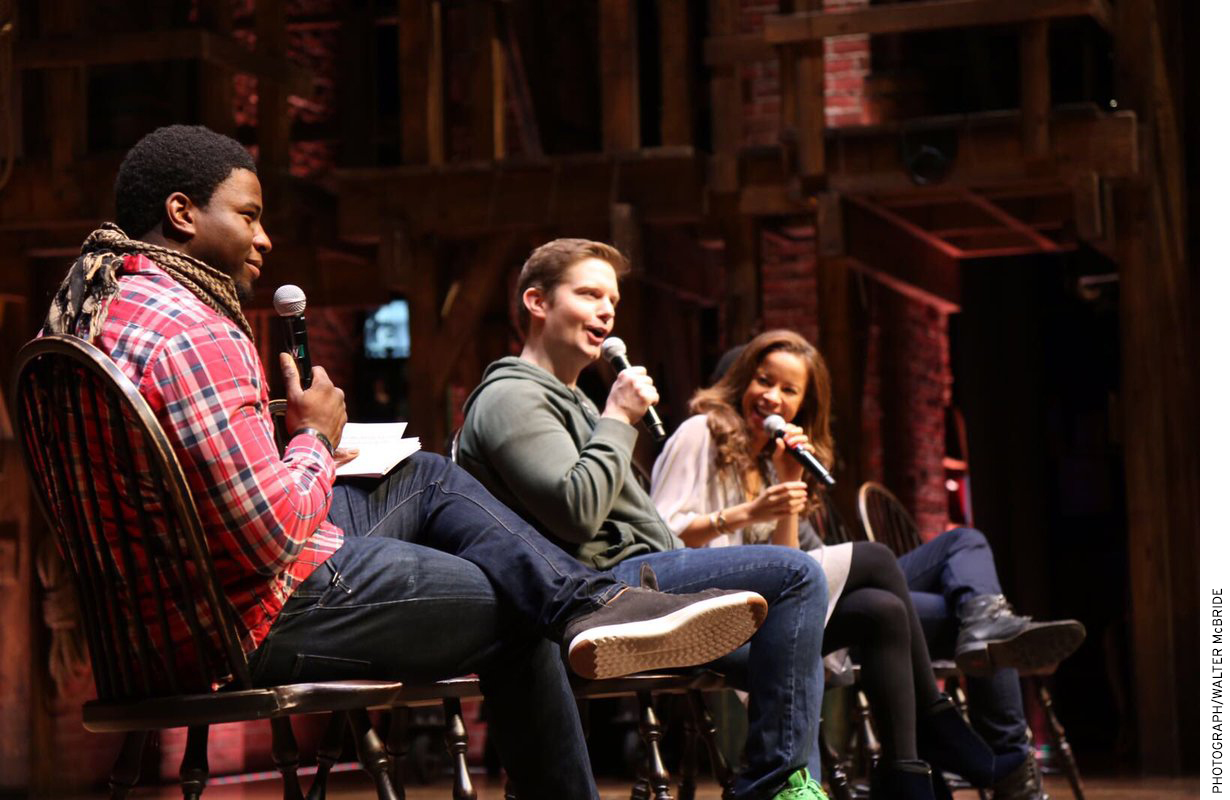
Using Diversity
Hamilton’s multicultural cast is integral to the production, and it makes sense that this diversity would also inform how students learn about both the historical period and the play. Students attending the performance so far come from low-income high schools and most are students of color. (San Francisco is an exception. The city has so few Title I schools that the program will bring in students from Oakland to participate.)
Mystic Morrison, a student from Brooklyn, says the cast’s racial composition reflects “real life. It’s nice to see not just one race [represented] onstage.”
Adds Joe White, a teacher at the John Adams High School in Queens: “The play is in language they understand.”
Miranda himself, who is of Puerto Rican descent, said during one of the talkbacks after a student performance, “When it comes to diversity on Broadway, it’s a prerequisite for what I do.” But he also mentioned a specific benefit of employing a multicultural cast. “I wanted to eliminate any distance between the story that happened 200-some-odd years ago and this audience of today. By using music of today and a set of actors that looks like our country, we eliminate that distance and see the whole story with a fresh set of eyes.”
Including Controversy
Of course, not all the drama around Hamilton has occurred onstage. At a performance in late November 2016, the cast addressed Vice President Elect Mike Pence, who was in the audience.
Actor Brandon Victor Dixon, who played Aaron Burr in that performance, told Pence: “We, sir, are the diverse America who are alarmed and anxious that your new administration will not protect us, our planet, our children, our parents, or defend us and uphold our inalienable rights. We truly hope that this show has inspired you to uphold our American values and to work on behalf of all of us.”
Miranda, who is prolific on Twitter, is not shy about trumpeting his political views, which lean decisively to the left.
When asked if this controversy would make schools less likely to use the play as a learning tool, Lawrence Paska says: “That’s going to depend on local school curriculum choices and planning. Some teachers and schools may use recent events as a way to highlight the intersection of history, art, and current events. Others may choose not to use works like Hamilton because they want to focus on historical events and not on recent activism.”
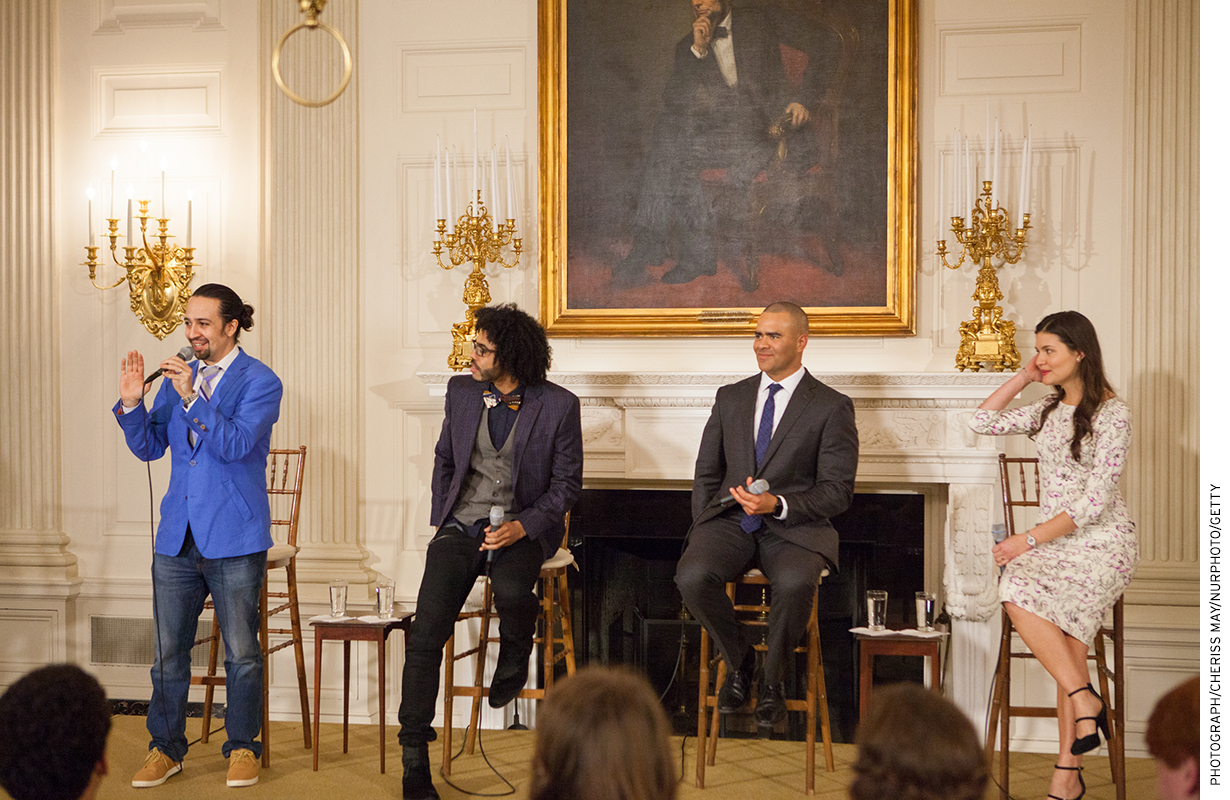
Praise from On High
No one involved with the play or the education program thinks this work is the be all and end all of U.S. history education.
“Hamilton isn’t the endpoint for these kids’ education, it’s the jumping-off point,” Miranda has said. “I hope it encourages people to learn more about their history. I never really cared much about American history because I didn’t see any connection between [that history] and the world I lived in.”
“It’s a story for all of us, about all of us,” former president Barack Obama has said.
When the cast performed at the White House in spring 2016, Obama praised the educational component of the program, saying, “I’m thrilled they are working with New York public schools. There’s now a curriculum to give students context and a deeper meaning—or deeper understanding of our nation’s founding. I hope this helps every teacher who spent hours trying to make The Federalist Papers teenager-friendly. The remarkable life of Alexander Hamilton will show our young people the possibilities within themselves and how much they can achieve within the span of a lifetime.”
As Miranda tells students when they come to see the play, the big question is, “What kind of world do we want to create? It’s no less than that. What kind of world are you going to create when you grow up?”
Wayne D’Orio is an award-winning education editor and writer who has covered education topics for more than a decade.
This article appeared in the Summer 2017 issue of Education Next. Suggested citation format:
D’Orio, W. (2017). Hamilton Goes to High School: How students are learning U.S. history from the hottest show on Broadway. Education Next, 17(3), 42-49.


